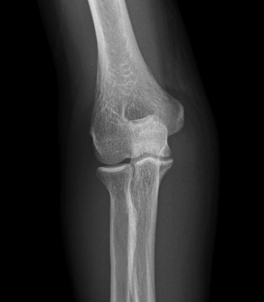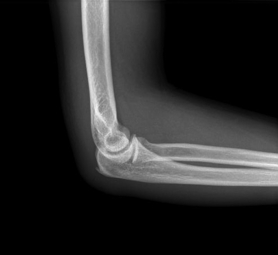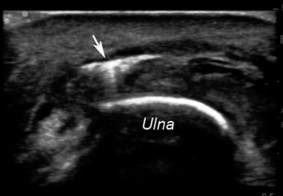Soft Tissue Ultrasound and the Comet Tail Artifact
A 46-year-old man presented with progressive elbow pain following an assault 1 week earlier. He stated that while defending himself, he hit his attacker in the mouth with his elbow. On physical exam, he had a small puncture wound overlying the proximal ulna, 3 cm distal to the olecranon. There was marked erythema and swelling over the elbow joint. Although the site was tender to the touch, there was no fluctuance, crepitus, or joint effusion, and the joint had full range of motion. The patient was afebrile, his white blood cell count was 14,000/mm3, and all other laboratory tests were normal. Radiographs of the elbow (1, 2) did not reveal any fractures, soft tissue foreign bodies, or gas. A bedside ultrasound was then performed using a 7.5-MHz linear transducer and revealed an echogenic area superficial to the ulna (the arrow in Figure 3), casting a bright trail of echoes. These findings were subsequently confirmed by computed tomography, and the patient was hospitalized for intravenous antibiotics, wound exploration, and pain management.

Elbow radiograph, anteroposterior view.

Elbow radiograph, lateral view.

Soft tissue ultrasound screen capture.
The comet tail artifact was first described by Ziskin et al. in 19821 and appears as a dense tapering trail of bright echoes just distal to a strongly reflective structure (Figure 3).1,2 In soft tissue, the comet tail is commonly caused by metal, plastic, or air. In this case, the absence of a foreign body on plain radiographs made subcutaneous gas the most likely cause. It is important to note that the ultrasound showed a pronounced comet tail artifact (see Video Clip S1), while the plain films were devoid of findings. Ultrasound is often more sensitive than plain radiographs for the detection of subtle soft tissue collections of air, and the comet tail artifact can thus be an early indicator of anaerobic or necrotic soft tissue infections.




